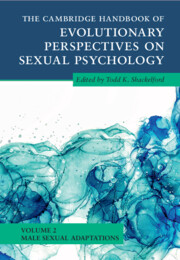Book contents
- The Cambridge Handbook of Evolutionary Perspectives on Sexual Psychology
- The Cambridge Handbook of Evolutionary Perspectives on Sexual Psychology
- Copyright page
- Contents
- Contributors
- Preface
- Part I Precopulatory Adaptations
- Part II Copulatory Adaptations
- Part III Postcopulatory Adaptations
- 14 Postejaculatory Adaptations to Self-Semen Displacement
- 15 Male Mate Retention
- 16 Shifts in Partner Attractiveness
- 17 Emotional Commitment in Men
- 18 Sexual Jealousy in Males
- 19 Men’s Attachment-Related Needs in the Sexual Arena
- 20 Paternal Care
- 21 Paternal Filicide
- Index
- References
16 - Shifts in Partner Attractiveness
Evolutionary and Social Factors
from Part III - Postcopulatory Adaptations
Published online by Cambridge University Press: 30 June 2022
- The Cambridge Handbook of Evolutionary Perspectives on Sexual Psychology
- The Cambridge Handbook of Evolutionary Perspectives on Sexual Psychology
- Copyright page
- Contents
- Contributors
- Preface
- Part I Precopulatory Adaptations
- Part II Copulatory Adaptations
- Part III Postcopulatory Adaptations
- 14 Postejaculatory Adaptations to Self-Semen Displacement
- 15 Male Mate Retention
- 16 Shifts in Partner Attractiveness
- 17 Emotional Commitment in Men
- 18 Sexual Jealousy in Males
- 19 Men’s Attachment-Related Needs in the Sexual Arena
- 20 Paternal Care
- 21 Paternal Filicide
- Index
- References
Summary
Researchers have spent decades investigating factors in attraction; biological variables, cultural norms, and social pressures have all had their time in the spotlight. Humans are complicated animals and each of these realms have shown measurable effects. However, evolutionary approaches provide a unifying theory that subsumes and explains each of these factors and how they interact to create intricate yet predictable patterns in human mating behavior. In this chapter, we give a brief summary of major factors influencing attractiveness as perceived by men, including biological factors such as age and ovulatory status but also social factors such as exposure to highly attractive, or simply novel, women. Understanding how attractiveness can vary over time and within relationships can be useful, not only to research but also in applied clinical fields such as couples’ and marital therapy.
- Type
- Chapter
- Information
- Publisher: Cambridge University PressPrint publication year: 2022



